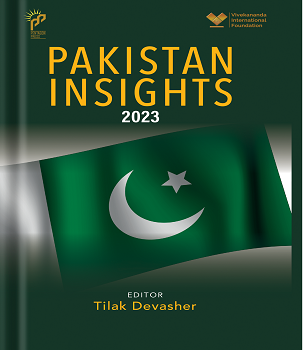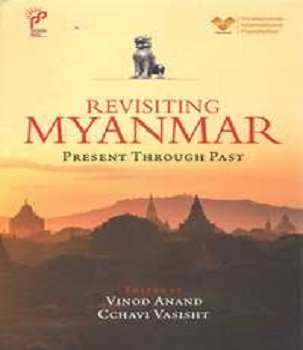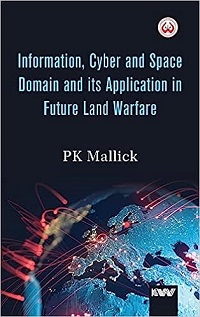Millions of smartphones or computers and their hardware all over the world with made-in-China tags provide a sense that the Dragon country is perhaps one of the most advanced IT-enabled countries. PLA soldiers are safe behind their high-tech Digital Fortress. Most of us have lived in this delusion for so many decades. General PK Mallick not only dispells this myth but also tears into the Chinese Digital Fortress. He brings out that China may have an advantage in hardware production. Still, for the lack of indigenous production of semiconductors, an essential component for IT, their dependency on other countries for connected software coding and its components has its inherent vulnerability fallout through the backdoor. Chinese cyber firewall may not be impregnable. American or Russians and not Chinese have dominated the antivirus domain. The reader will know about ‘Eight Guardian Warriors’ of America, whose software is the backbone of Chinese Cyber architecture. Even their exclusive IT manufacturing company, like Huawei’s smart products switches and hardware, may have been contaminated by the National Security Agency of America. In this book on Cyber domain of China, a closer look provided by General PK Mallick peels open hidden weaknesses of the Chinese Cyber Domain to the core.
PLA is creating situations unworthy of a professional army of the twenty-first century with their uncivilised and hooliganism along the Line of Actual Control with India in fighting with ancient barbaric tools like maces spiked with nails. On the other hand, China brought in their sophisticated satellite tracking vessel Yuan Wang 5 at Hambantota Port of Sri Lanka (16 -22 August 22). The importance of this sophisticated warship disguised as a civilian marine survey ship would not have come to the fore without detailed knowledge of military-civil fusion for creating dual-purpose hardware platforms of PLA. It is becoming more prudent to examine the hard and soft military power of PLA as it will continue to manifest soon. While frontline warriors will fight Kinetic War for occupation of legitimised land, the importance of winning the mind game through soft power will remain. This book looking into the contemporary soft power of China will facilitate not only an understanding of the digital fortress of PLA in forward areas by frontline warriors but also national planners to think and plan aggressively to counter threats of the cyber domain.
General PK Mallick has written over a hundred professional monographs and papers and contributed immensely at national-level seminars on radio-electromagnetic aspects that are exclusively related to the defence sector. At a very early stage of his military career, he developed a keen sense of analysing contemporary issues. His online knowledge repository is very exhaustive. The content of his websites has not been accumulated in a few days or months but through sustained efforts over decades. Visitor counters for his websites on https://www.strategicstudyindia.com/ and https://indianstrategicknowledgeonline.com/ reflect professional acceptance among warrior scholars. During and post-COVID, he has written extensively on cyber, which can be accessed at his website, ResearchGate and Academia.edu. This book, China in the Cyber Domain, has a collection of his articles written in the past few years and reflects his command of the subject matter.
Book contents can be broadly grouped into three independent but interconnected clusters. The first five chapters deal with definition, concept, doctrine and hierarchical organisations dealing with cyber aspects in China. The second cluster deals with contemporary cyber espionage and cyber influence operations. The third segment deals with the military civil fusion of cyber assets, their vulnerabilities and locus standi in the international arena. General PK Mallick, with his craftsmanship, compressed these three aspects to generate interest and opened up windows to the reader, who may use exhaustive endnotes at the end of each chapter to expand his horizon. All three clusters bring out another interesting progression of the narrative. In the defence forces, it is said that a warrior scholar should spend the initial few years of his service understanding the basic tenets of his weapon system or the nature of the hundred of soldiers he commands at the company level. This ground reality helps shape his foundation and culminates in his selection for Defence Services Staff College. The first cluster of five chapters is meant for these warrior scholars who have interest or by virtue of being in technical stream pursue cyber domain of China. A young scholar’s cursory look at the remaining chapters is enough to build up his curiosity and generate awareness of malicious apps like WeChat or TikTok and many others, as mentioned in the book. After commanding a unit and being nominated for mid-level career course of Higher Command, the same warrior scholar needs to empower his knowledge on the second cluster comprising of espionage and its influence operations in the world. Thereafter, at the peak of his career, a warrior scholar is required to add on to service-specific policies. The third cluster on interplay of various agencies at the national level in China gives a broad framework for possible formulation of own countermeasures. Therefore, this book, read by three different generations of warriors will find its usefulness. Its content will continue to be an effective tool for all generations with undiminished intrinsic values for both defence force professionals as well as bureaucratic policymakers of the nation.
In the first five chapters, General Mallick brings out the evolution of PLA from Mao Zedong (1949 - 1976) to the present day President Xi Jinping. PLA, under successive leaders, have undergone purging in the name of modernisation. People’s War of Mao Zedong transited from Local wars under modern condition to the current doctrine of Intelligentised War. It establishes information dominance by exploiting information more rapidly and accurately than the adversary. The author draws his observations from Chinese White Papers on defence, Communist Party reports and military scholars' inputs. Post-2015 reorganisation of PLA, General Mallick highlighted that the current modernisation programme has been the most ambitious. It retained the structure inherited from Mao and Deng era. It has made only incremental changes to meet the demands of fighting and winning local wars under informationalised conditions. The current five Commands replacing the earlier seven Military Regions have been aimed at integrating components of all three services. Four existing General Departments have been broken into 15 organs directly under the Chinese Military Commission. It elevated and redesignated Second Artillery Force to PLA Rocket Force and integrated all logistics to PLA Joint Logistic Support Force. It created a new PLA Strategic Support Force to look after Space, Electronic Warfare and Cyber operations. The author admits that PLA is retaining its old organisational structure and concludes that Strategic Support Force creation implies the growing importance of Information Warfare in all operations. General Mallick also expresses his scepticism at the broad-brush changes and calls it as ‘above the neck reform’.
The second cluster on Cyber Espionage and Influence Operations in Chapter seven and eight is based on a few rarely accessible documents. China’s cyber espionage is directed at strengthening its economy and production of cutting-edge military hardware through reverse engineering. Research work worth billions of dollar are available with China by spending few millions only through cyber espionage. Weapons of future developed by America are available and on display to be sold to buyers. The author introduces Ghost net, Operation Aurora and data war, about which very little or no credible information is available. The most interesting part of the book is written on Cyber Influence Operations. General Mallick begins with the definition of various organisations and the role of social media in propagating the same to the target audience. The author explains terms such as Wolf Warrior activities during COVID, Thousand Talent Programme, Fifty Cent Party and Mask diplomacy. The concept of Content Farm to generate mass propaganda material by the PLA is amazing. Case studies on influencing elections in America and Taiwan are another eye-opener issue. Reading about Chinese efforts to propagate their party line at international fora through Government organised Non-Government organisations is fascinating. All the influence operation activities justify billions of dollars spent by the Chinese towards them.
The third cluster has to be read with Chapter six on the management of cyber security, with the remaining three chapters on Military Civil Fusion, Limitations and Vulnerability and China’s role in the international order. Chapter six gives a real audit or SWOT on China’s Cyber Domain under the subhead, deficiencies in China’s cyber security mechanism. This portion gives out scope for the evolution of our own counter strategy. China fears the role of Eight Guardian Warriors, all American IT companies, in their IT architecture. Indian diaspora employed with these guardians can be of immense help if the government of the day so desires.
In some places, diagrams, flow charts and sentences, including Chinese cliché are repetitive, which has been done to emphasise the points.
This book, China in the Cyber Domain, is recommended for all the training institutes, defence libraries, formations, units and Defence Officers who have to deal with China as an adversary in the near future. The book is best understood when the chapters are converted to powerpoint slides, with the presenter having access to all its endnotes for broader understanding. Another advantage is the easy accessibility of the author, Major General PK Mallick, through his daily posting on his websites, emails and monthly bulletin of Strategic Study India.
We look forward to many such well-researched scholarly works from General PK Mallick’s Wisdom Farm. It appears I am also greatly influenced by his seminal work.











Post new comment